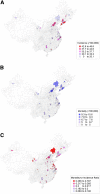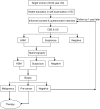Breast Cancer Challenges and Screening in China: Lessons From Current Registry Data and Population Screening Studies
- PMID: 26001390
- PMCID: PMC4492227
- DOI: 10.1634/theoncologist.2014-0351
Breast Cancer Challenges and Screening in China: Lessons From Current Registry Data and Population Screening Studies
Abstract
Background: As one of its responses to the increasing global burden of breast cancer (BC), China has deployed a national registration and BC screening campaign. The present report describes these programs and the initial results of these national BC control strategies, highlighting the challenges to be considered.
Materials and methods: The primary BC incidence and prevalence data were obtained from the Chinese National Central Cancer Registry. MapInfo software was used to map the geographic distribution and variation. The time trends were estimated by the annual percentage of change from 2003 to 2009. The description of the screening plans and preliminary results were provided by the Ministry of Health.
Results: Chinese cancer registries were primarily developed and activated in the East and Coastal regions of China, with only 12.5% of the registries located in West China. Geographic variation was noted, with the incidence of BC higher in North China than in South China and in urban areas compared with rural areas. Of great interest, these registries reported that the overall BC incidence has been increasing in China, with an earlier age of onset compared with Western countries and a peak incidence rate at age 50. In response to this increasing incidence and early age of onset, BC screening programs assessed 1.46 million women aged 35-59 years, using clinical breast examinations and ultrasound as primary screening tools between 2009 and 2011. The diagnostic rate for this screening program was only 48.0/10(5) with 440 cases of early stage BC. Early stage BC was detected in nearly 70% of screened patients. Subsequently, a second-generation screening program was conducted that included older women aged 35-64 years and an additional 6 million women were screened.
Conclusion: The cancer registration system in China has been uneven, with a greater focus on East rather than West China. The data from these registries demonstrate regional variation, an increasing BC incidence, and an early age of onset. The 2009 to 2011 BC screening program targeting women aged 35-59 years had a low detection rate that resulted in a second-generation screening program that extended the cohort size and ages screened to 35-64 years.
Implications for practice: Cancer registration has been active in China for decades; however, a national survey of registries has not been routinely reported. This study used MapInfo to describe the reported data and found asymmetric registration activities, geographic variations in breast cancer (BC) burdens, and an increasing incidence with a peak at age 50. The initial Chinese BC screening programs focused on a relatively young population of women aged 35-59 years and had a low detection rate, but 69.7% of patients had early stage BC. Older women were included in the second-generation screening programs, and an additional 6 million women were screened. Consideration of regional variations and age is necessary to optimize the efficiency and utility of BC screening in China, with the ultimate goal to reduce BC mortality.
摘要
背景. 作为对全球乳腺癌(BC)负担持续上升的回应措施之一,中国已经部署了全国性乳腺癌登记和乳腺癌筛查工作。本报告对这些项目进行了说明,并且给出了这些国家级乳腺癌控制策略的初步成果,强调了一些应该考虑到的挑战。
材料与方法. 原发性乳腺癌的发病率与患病率数据来自中国肿瘤登记中心。使用MapInfo软件绘制地理分布和变化。根据2003年至2009年的年度频率改变估计时间趋势。筛查计划的说明和初步结果由卫生部提供。
结果. 中国肿瘤登记项目主要在华东和沿海地区开展和进行,只有12.5%的登记点位于华西地区。乳腺癌发病率的地理差异很明显,华北高于华南,城市地区高于农村地区。最值得注意的是,这些登记报告了中国总体乳腺癌发病率正在上升,并且发病年龄早于西方国家,发病率在50岁达到最高峰。鉴于这一发病率升高及发病提早的情况,乳腺癌筛查项目在2009年至2011年使用临床乳腺癌检查和超声作为主要筛查工具,对146万名35 ∼ 59岁的女性进行了评估。该筛查项目发现了440例早期乳腺癌,诊断率仅为48.0/105。而在接受筛查的患者中,近70%发现早期乳腺癌。随后,在年龄较大的35 ∼ 64岁女性以及另外600万名女性中开展了二代筛查项目。
结论. 中国肿瘤登记系统分布不均衡,华东地区比重高于华西地区。来自这些登记中心的数据表明存在地区差异、乳腺癌发病率升高,以及发病时间提早。2009年至2011年乳腺癌筛查项目的目标人群为35 ∼ 59岁女性,由于检出率低,故二代筛查项目扩大了队列样本,并且将筛查年龄调整为35 ∼ 64岁。The Oncologist 2015;20:773–779
Keywords: Breast cancer; Incidence; Mapping; Mortality; Screening.
©AlphaMed Press.
Conflict of interest statement
Disclosures of potential conflicts of interest may be found at the end of this article.
Figures





Similar articles
-
Italian cancer figures, report 2012: Cancer in children and adolescents.Epidemiol Prev. 2013 Jan-Feb;37(1 Suppl 1):1-225. Epidemiol Prev. 2013. PMID: 23585445 English, Italian.
-
Breast cancer age at diagnosis patterns in four Latin American Populations: A comparison with North American countries.Cancer Epidemiol. 2015 Dec;39(6):831-7. doi: 10.1016/j.canep.2015.10.004. Epub 2015 Oct 24. Cancer Epidemiol. 2015. PMID: 26651442
-
[Report of breast cancer incidence and mortality in China registry regions, 2008-2012].Zhonghua Zhong Liu Za Zhi. 2019 Apr 23;41(4):315-320. doi: 10.3760/cma.j.issn.0253-3766.2019.04.013. Zhonghua Zhong Liu Za Zhi. 2019. PMID: 31014059 Chinese.
-
Trends in epidemiology and management of breast cancer in developing Arab countries: a literature and registry analysis.Int J Surg. 2007 Aug;5(4):225-33. doi: 10.1016/j.ijsu.2006.06.015. Epub 2006 Aug 24. Int J Surg. 2007. PMID: 17660128 Review.
-
Descriptive epidemiology of breast cancer in China: incidence, mortality, survival and prevalence.Breast Cancer Res Treat. 2016 Oct;159(3):395-406. doi: 10.1007/s10549-016-3947-0. Epub 2016 Aug 25. Breast Cancer Res Treat. 2016. PMID: 27562585 Review.
Cited by
-
Biological effect of ribosomal protein L32 on human breast cancer cell behavior.Mol Med Rep. 2020 Sep;22(3):2478-2486. doi: 10.3892/mmr.2020.11302. Epub 2020 Jul 6. Mol Med Rep. 2020. PMID: 32705264 Free PMC article.
-
Alteration of the immune microenvironment in the axillary metastatic lymph nodes of luminal A breast cancer patients.World J Surg Oncol. 2024 Jun 27;22(1):172. doi: 10.1186/s12957-024-03454-x. World J Surg Oncol. 2024. PMID: 38937736 Free PMC article.
-
Breast cancer in previously thyroidectomized patients: which thyroid disorders are a risk factor?Future Sci OA. 2021 Mar 29;7(5):FSO699. doi: 10.2144/fsoa-2021-0029. Future Sci OA. 2021. PMID: 34046196 Free PMC article. Review.
-
Comparison of pathological characteristics between self-detected and screen-detected invasive breast cancers in Chinese women: a retrospective study.PeerJ. 2018 Apr 26;6:e4567. doi: 10.7717/peerj.4567. eCollection 2018. PeerJ. 2018. PMID: 29713563 Free PMC article.
-
Multicenter cross-sectional screening of the BRCA gene for Chinese high hereditary risk breast cancer populations.Oncol Lett. 2018 Jun;15(6):9420-9428. doi: 10.3892/ol.2018.8538. Epub 2018 Apr 18. Oncol Lett. 2018. PMID: 29805665 Free PMC article.
References
-
- Ferlay J, Soerjomataram I, Ervik M et al. Globocan 2012 v1.0, cancer incidence and mortality worldwide. IARC Cancerbase no. 11 [Internet]. Lyon, France: International Agency for Research on Cancer; 2013. Available at http://www.globocan.Iarc.Fr. Accessed July 7, 2014.
-
- Zhao P, Chen W, Kong L. Cancer Incidence and Mortality in China, 2003–2007. Beijing: Military Medical Science Press; 2011.
-
- He J, Chen W. Chinese Cancer Registry Annual Report 2012. Beijing: Military Medical Science Press; 2013.
-
- Segi M. Cancer Mortality for Selected Sites in 24 Countries (1950-57) Sendai, Japan: Department of Public Health, Tohoku University of Medicine; 1960.
-
- Kim HJ, Fay MP, Feuer EJ, et al. Permutation tests for joinpoint regression with applications to cancer rates. Stat Med. 2000;19:335–351. - PubMed
MeSH terms
LinkOut - more resources
Full Text Sources
Other Literature Sources
Medical
Research Materials

